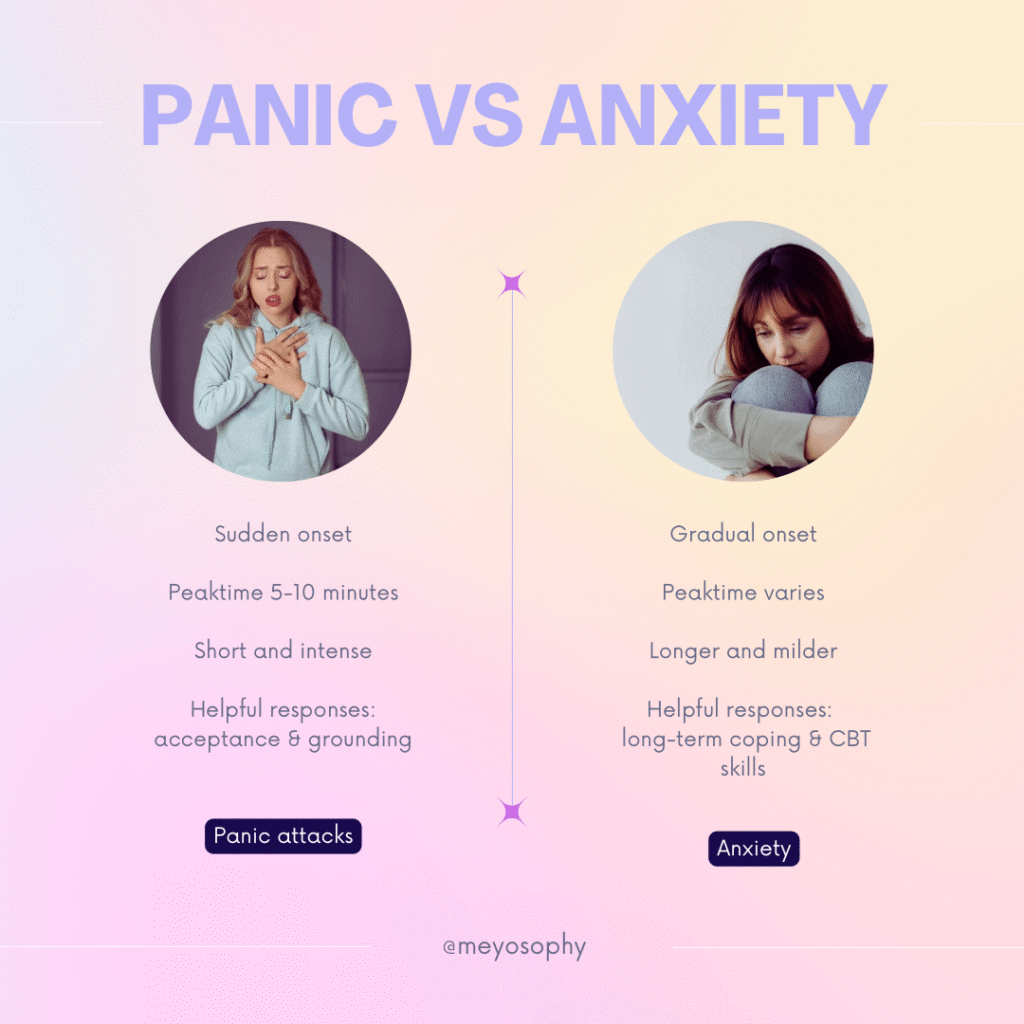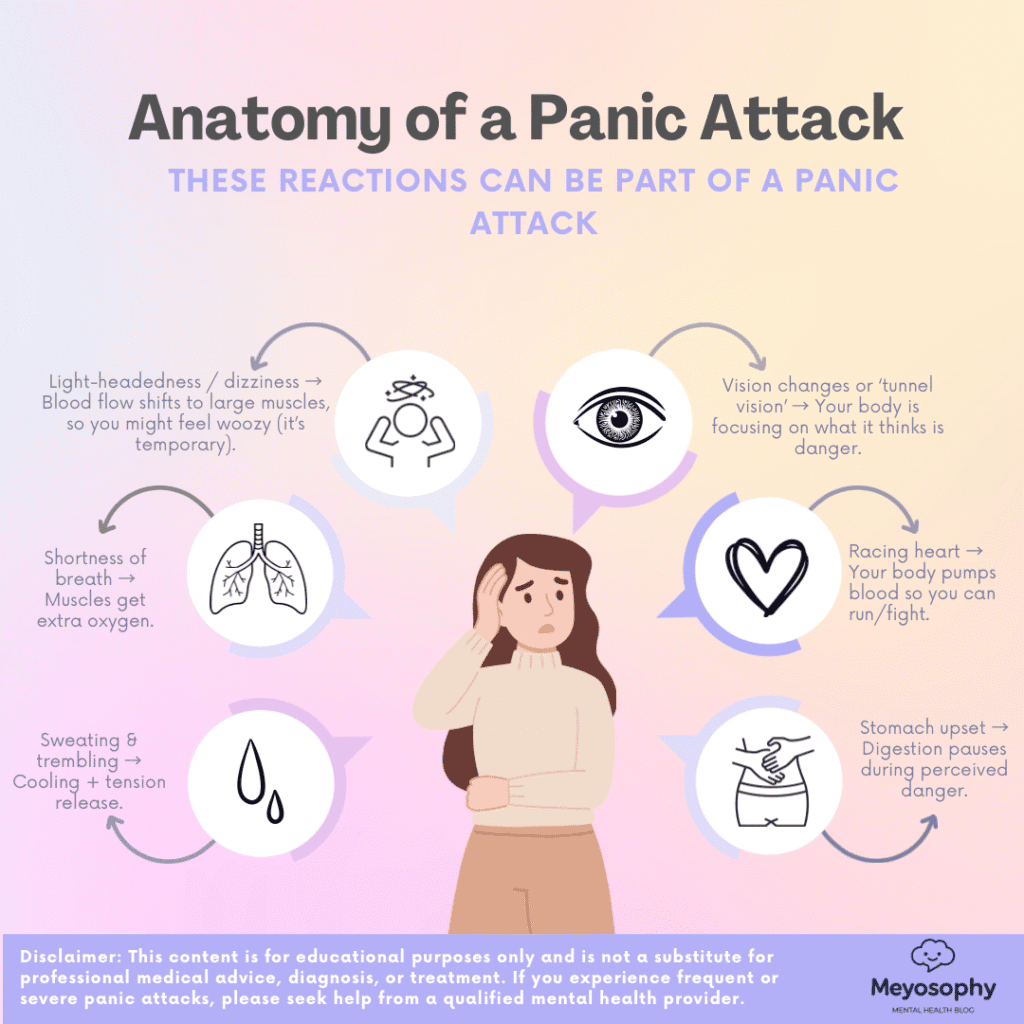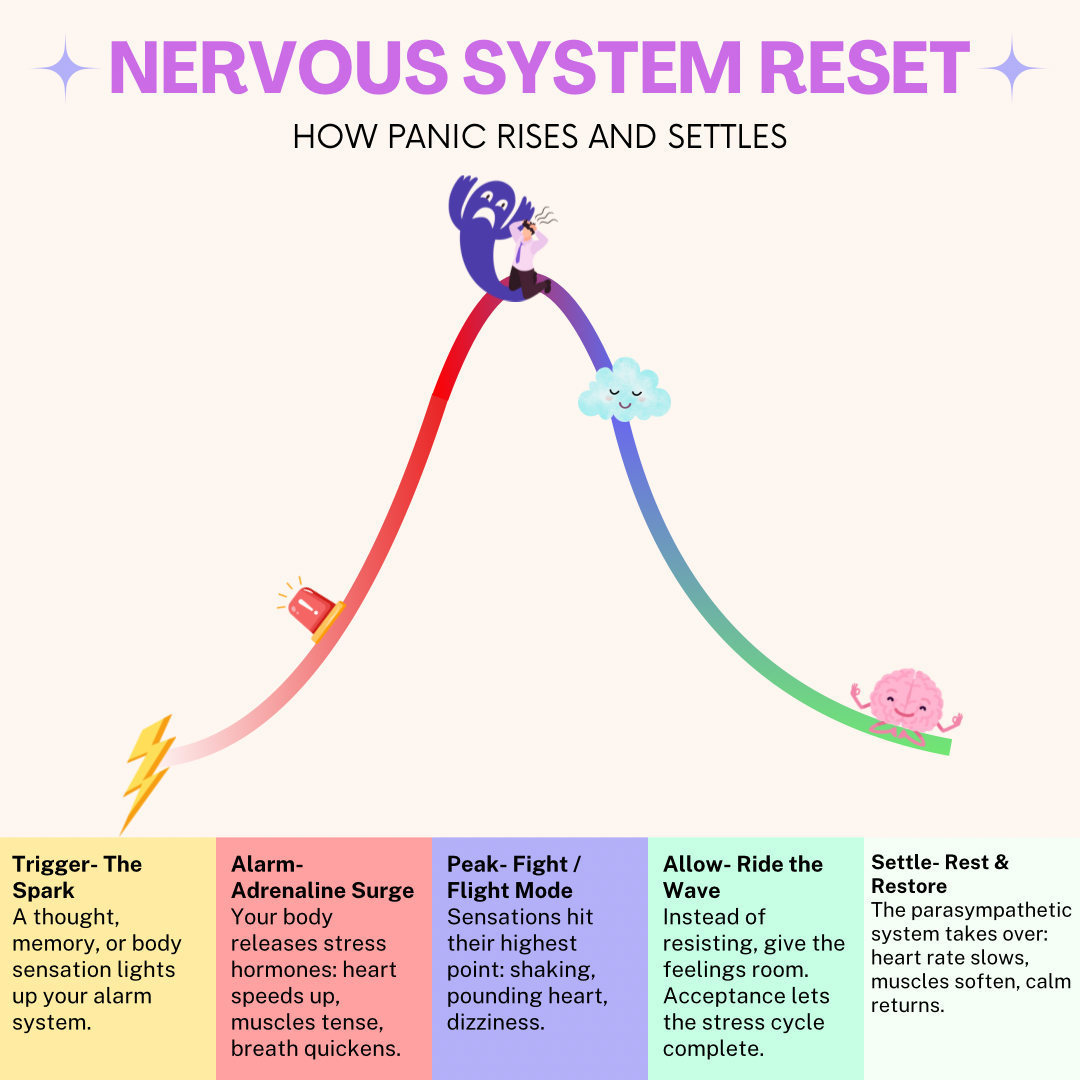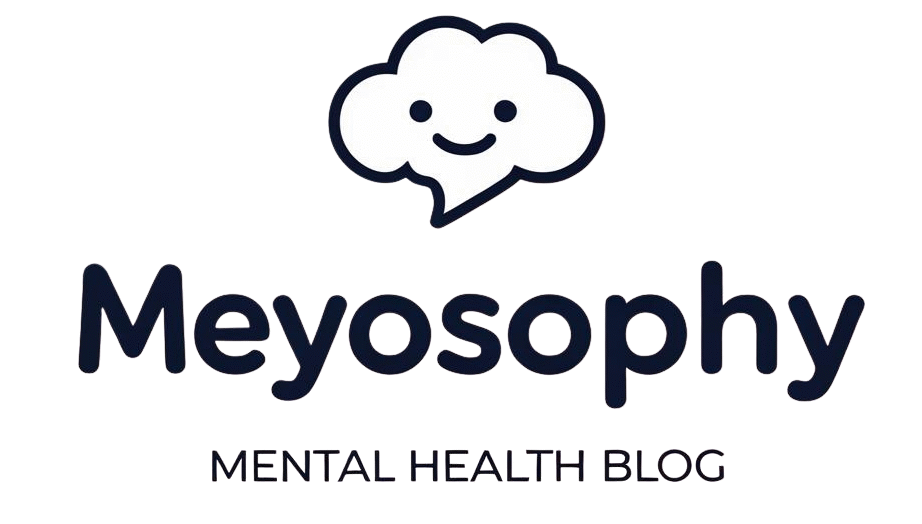Disclaimer: I’m not a mental health professional, everything here is shared from research and personal experience. If you’re feeling overwhelmed or need support, please consider talking to a qualified professional. You’re not alone. If you’re in the U.S., you can call or text 988 anytime. For help in other countries, visit https://findahelpline.com.
If panic attacks scare you, you’re not alone. They’re terrifying in the moment. The good news: panic attacks are usually short-lived, not physically dangerous, and they make more sense once you know what your body is doing. This post will demystify panic attacks, explain how they differ from general anxiety, show what happens inside your body, list common triggers, and map how panic builds and settles (so the next time it happens you know what to do and why).
What panic attacks are and what they aren’t
A panic attack is a sudden surge of intense fear or discomfort that peaks within minutes and is usually accompanied by strong physical symptoms (racing heart, breathlessness, trembling, dizziness, nausea, or a sense of losing control) even when there’s no real danger present. Panic attacks often come on abruptly and can happen to anyone; when they happen repeatedly and lead to persistent worry about future attacks, clinicians may diagnose panic disorder. Most panic attacks last between about 5 and 20 minutes, with symptoms often at their worst within the first 10 minutes. They can feel like an emergency, but they are not likely to cause physical harm. [1][2][3][4]
Quick difference: panic attacks are sudden and intense; general anxiety tends to be slower-building and longer-lasting.

What happens inside your body during a panic attack
Think of a panic attack as a false alarm. Your brain senses danger (sometimes from a thought, memory, or bodily sensation) and pulls the emergency brake: the sympathetic nervous system fires, releasing adrenaline and other stress hormones. That surge prepares your body to run or fight: heart and breathing rate increase, muscles tense, digestion slows, and you may start to sweat and shake. Those physical responses are useful in real danger, but during a panic attack they’re just the body doing its job in the wrong moment. [6][7]
Important: while frightening, these physical effects are typically temporary and self-limiting. The body returns to baseline once the alarm quiets down. [1][3][6]

Common triggers: what often sets off that alarm
Panic attacks sometimes seem to come “out of the blue,” but common triggers include things that sensitize your system:
- Caffeine or alcohol (both can increase heart rate or jitteriness). [5][9]
- Poor sleep or exhaustion. [5]
- Big life transitions or acute stress (breakups, job changes). [5]
- Social stress (crowds, public speaking). [5]
- Health worries or bodily sensations (a fluttering heart that the brain interprets as threat). [3]
- Hormonal shifts (e.g., menstrual cycle, pregnancy, menopause). [5]
- Over-breathing (hyperventilation), which can itself trigger dizziness and tingling. [7]
Knowing your triggers helps you stay curious, not fearful. That curiosity can help you reduce avoidant behaviors and plan simple changes (like lowering caffeine, improving sleep, or practicing short grounding exercises).

How panic builds and how it calms
Panic follows a curve: it starts small, ramps up into a peak, and then comes down again. Here’s what the curve looks like:
- Trigger – The spark. A thought, sensation, or situation activates your alarm.
- Alarm – Adrenaline surge. Heart rate and breathing increase; muscles tense.
- Peak – Fight/flight. Sensations feel overwhelming; fear may spike.
- Allow – Ride the wave. Accepting the sensations (not fighting them) helps the body finish the stress cycle.
- Settle – Rest & restore. The parasympathetic system activates: heart slows, muscles relax, digestion returns. [6][8]
Resistance usually prolongs the alarm. Trying to will the panic away (“stop now!”) can escalate the experience. Acceptance, noticing and labeling the sensations, helps the nervous system downshift. Simple breathing, grounding, or gentle movement practices help move you from the “peak” toward “settle.” [3][6] Ps. I know this is harder then it sounds.

When to seek help (and what treatment looks like)
If panic attacks are frequent, cause you to avoid normal activities, or leave you constantly worried about future attacks, it’s time to talk to a clinician. Treatments include cognitive-behavioral therapy (CBT), which teaches skills to break unhelpful thought patterns and avoidant behavior. In some cases medication is used that reduces the intensity or frequency of attacks. A trained professional can also check for physical causes and help build a personalized plan. [2][6][10]
If you experience sudden chest pain, fainting, or unusual symptoms for the first time, seek urgent medical evaluation to rule out physical conditions. But remember: for most people, panic attacks aren’t dangerous. They’re alarming to you, but manageable with the right support. [1][2]
Disclosure: This post contains Amazon affiliate links. That means if you click and make a purchase, I may earn a small commission at no extra cost to you. I only recommend products I truly believe in. Thank you for supporting this blog and helping me keep the content free and helpful! 💛
Helpful Books & Tools
Many people find reassurance and guidance in practical resources like books. “DARE: The New Way to End Anxiety and Stop Panic Attacks” by Barry McDonagh is a reader favorite (and mine) for its hands-on approach. Other tools you could look at include:
- Hope and Help for Your Nerves by Dr. Claire Weekes – classic tips on “floating through” anxiety.
- Audio or app-based breathing exercises (e.g., Calm, Headspace).
- Journaling or grounding cards to remind you of coping scripts mid-attack (more on this in my next blog)
These tools teach you to meet panic with curiosity instead of fear, making each episode less intimidating over time[^11].
My Story with Panic Attacks
I’ve experienced multiple panic attacks myself, and they were terrifying. Each time, I thought I might die or lose control completely. Fighting against the feelings only made the storm stronger. What finally helped was acceptance. Letting the sensations rise and fall like a wave. Reading DARE gave me the words and courage to stop resisting. I also learned that panic isn’t just physical (racing heart, breathlessness), there’s a massive mental side too: spiraling “what if?” thoughts that need gentle reassurance rather than analysis is just one of them. There are too many symptoms to mention. Just know that I know it’s hard and scary. But knowing what’s happening, time and having the right tools make a big difference. For me they are still scary, but like I said much easier to handle then in the beginning. I hope, if you struggle with panic, that it will get easier for you too.
You’re not broken, you’re human
Panic attacks feel like proof something is terribly wrong. In reality, they’re the brain and body doing their protective job too well. Understanding what triggers them, what the physical signs mean, and how the nervous system cycles up and down gives you power: to accept, to intervene with simple tools, and to seek help when needed.
If this article helped you feel less alone, the follow-up post: “Coping With Panic Attacks: Practical Tools for During & After” will give step-by-step strategies, calming scripts for your phone, and recovery tips. Bookmark this post, save the infographics to your phone, and know: panic is intense but usually short-lived and you can learn to ride the wave.
Sources & further reading
- NHS: Panic disorder. https://www.nhs.uk/mental-health/conditions/panic-disorder/
- Mayo Clinic: Panic attacks and panic disorder: Symptoms and causes. https://www.mayoclinic.org/diseases-conditions/panic-attacks/symptoms-causes/syc-20376021
- Harvard Health Publishing: Panic attacks: Recognizing and managing panic attacks and preventing future attacks. https://www.health.harvard.edu/mind-and-mood/panic-attacks-recognizing-and-managing-panic-attacks-and-preventing-future-attacks
- Mind UK: What is a panic attack? https://www.mind.org.uk/information-support/types-of-mental-health-problems/anxiety-and-panic-attacks/panic-attacks/
- Medical News Today: Anxiety: symptoms, types, causes, prevention, and treatment (section on triggers). https://www.medicalnewstoday.com/articles/323454
- National Institute of Mental Health (NIMH): Panic Disorder: When Fear Overwhelms. https://www.nimh.nih.gov/health/publications/panic-disorder-when-fear-overwhelms
- Medical News Today: What does anxiety feel like, and how does it affect the body? (breathing/hyperventilation). https://www.medicalnewstoday.com/articles/322510
- Massachusetts General Hospital: The Vagus Nerve: A Key Player in Your Health and Well-Being. https://www.massgeneral.org/news/article/vagus-nerve
- Klevebrant L., et al. (2022). Effects of caffeine on anxiety and panic attacks in patients (study summary). https://www.sciencedirect.com/science/article/pii/S0163834321001614
- Cleveland Clinic: Panic Attacks & Panic Disorder. https://my.clevelandclinic.org/health/diseases/4451-panic-attack-panic-disorder
- McDonagh, B. (2015). DARE: The New Way to End Anxiety and Stop Panic Attacks.

